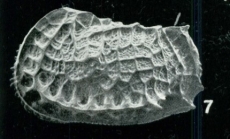Ostracoda taxon details
Bradleya pelasgica Whatley, Downing, Kesler & Harlow, 1984
461429 (urn:lsid:marinespecies.org:taxname:461429)
accepted
Species
marine, fresh, terrestrial
Whatley, R.C., Downing, S.E., Kesler, K. and Harlow, C.J. (1984a) New species of the ostracod genus Bradleya from the Tertiary and Quaternary of D.S.P.D.P. sites in the southwest Pacific. Revista Espanola de Micropaleontologia 16, 265–298. [details]
Type locality contained in Lord Howe Rise
type locality contained in Lord Howe Rise [details]
Description Medium, moderately robust. Sub-rectangular. Anterior margin broadly and asymmetrically convex with extremity below...
Etymology Gr. With reference to the ongms of this species in the bathyal realm of the Lord Howe Rise.
Description Medium, moderately robust. Sub-rectangular. Anterior margin broadly and asymmetrically convex with extremity below mid-height; denticulate with approximately 20 moderately long marginal denticles. Posterior narrower, truncate with slight concavity postero-dorsally in RV only; approximately six marginal denticles. Dorsal margins straight to slightly concave with anterior hinge ear and postero-dorsal spine in LV only. Ventral margin straight to slightly convex. Maximum length below midheight; maximum height at anterior cardinal angle; maximum width in posterior third. LV slightly larger than and overlapping RV dorsally. Reticulum rather low. Ventro-Iateral ridge strong, continuous around anterior margin into an ocular ridge which is rather less strongly emphasized and only sub-parallel to the anterior margin. Dorsal ridge moderately well developed, spinose in its posterior half. Bridge subdued, sub-rectangular with anterodorsal corner right-angled and antero-ventral corner rounded. Reticulum low, regular with equal emphasis of horizontal and vertical elements. Muri low, sparsely foveolate. Fossae open, shallow with weak secondary divisions and secondary reticulation. Posterior reticulum a box-like network with a group of 4 subquadrate central fossae. Normal pore canal distribution as for the genus. Internal features as for the genus; crenulate median element in hinge. [details]
Etymology Gr. With reference to the ongms of this species in the bathyal realm of the Lord Howe Rise.
Etymology Gr. With reference to the ongms of this species in the bathyal realm of the Lord Howe Rise. [details]
Brandão, S.N.; Antonietto, L.S; Nery, D.G.; Pereira, J.S.; Praxedes, R.A.; Santos, S.G.; Karanovic, I. (2024). World Ostracoda Database. Bradleya pelasgica Whatley, Downing, Kesler & Harlow, 1984. Accessed at: https://www.marinespecies.org/ostracoda/aphia.php?p=taxdetails&id=461429 on 2024-11-19
Date
action
by
original description
Whatley, R.C., Downing, S.E., Kesler, K. and Harlow, C.J. (1984a) New species of the ostracod genus Bradleya from the Tertiary and Quaternary of D.S.P.D.P. sites in the southwest Pacific. Revista Espanola de Micropaleontologia 16, 265–298. [details]
basis of record Jellinek, T. & Swanson, K.M. (2003). Report on the taxonomy, biogeography and phylogeny of mostly living benthic Ostracoda (Crustacea) from deep-sea samples (Intermediate Water depths) from the Challenger Plateau (Tasman Sea) and Campbell Plateau (Southern Ocean), New Zealand. <em>Abhandlungen der Senckenbergischen Naturforschenden Gesellschaft.</em> 558:1-329. (look up in IMIS) [details] Available for editors [request]
[request]
additional source Webber, W.R., G.D. Fenwick, J.M. Bradford-Grieve, S.G. Eagar, J.S. Buckeridge, G.C.B. Poore, E.W. Dawson, L. Watling, J.B. Jones, J.B.J. Wells, N.L. Bruce, S.T. Ahyong, K. Larsen, M.A. Chapman, J. Olesen, J.S. Ho, J.D. Green, R.J. Shiel, C.E.F. Rocha, A. Lörz, G.J. Bird & W.A. Charleston. (2010). Phylum Arthropoda Subphylum Crustacea: shrimps, crabs, lobsters, barnacles, slaters, and kin. <em>in: Gordon, D.P. (Ed.) (2010). New Zealand inventory of biodiversity: 2. Kingdom Animalia: Chaetognatha, Ecdysozoa, Ichnofossils.</em> pp. 98-232 (COPEPODS 21 pp.). [details] Available for editors [request]
[request]
basis of record Jellinek, T. & Swanson, K.M. (2003). Report on the taxonomy, biogeography and phylogeny of mostly living benthic Ostracoda (Crustacea) from deep-sea samples (Intermediate Water depths) from the Challenger Plateau (Tasman Sea) and Campbell Plateau (Southern Ocean), New Zealand. <em>Abhandlungen der Senckenbergischen Naturforschenden Gesellschaft.</em> 558:1-329. (look up in IMIS) [details] Available for editors
additional source Webber, W.R., G.D. Fenwick, J.M. Bradford-Grieve, S.G. Eagar, J.S. Buckeridge, G.C.B. Poore, E.W. Dawson, L. Watling, J.B. Jones, J.B.J. Wells, N.L. Bruce, S.T. Ahyong, K. Larsen, M.A. Chapman, J. Olesen, J.S. Ho, J.D. Green, R.J. Shiel, C.E.F. Rocha, A. Lörz, G.J. Bird & W.A. Charleston. (2010). Phylum Arthropoda Subphylum Crustacea: shrimps, crabs, lobsters, barnacles, slaters, and kin. <em>in: Gordon, D.P. (Ed.) (2010). New Zealand inventory of biodiversity: 2. Kingdom Animalia: Chaetognatha, Ecdysozoa, Ichnofossils.</em> pp. 98-232 (COPEPODS 21 pp.). [details] Available for editors
 Present
Present  Inaccurate
Inaccurate  Introduced: alien
Introduced: alien  Containing type locality
Containing type locality
From editor or global species database
Description Medium, moderately robust. Sub-rectangular. Anterior margin broadly and asymmetrically convex with extremity below mid-height; denticulate with approximately 20 moderately long marginal denticles. Posterior narrower, truncate with slight concavity postero-dorsally in RV only; approximately six marginal denticles. Dorsal margins straight to slightly concave with anterior hinge ear and postero-dorsal spine in LV only. Ventral margin straight to slightly convex. Maximum length below midheight; maximum height at anterior cardinal angle; maximum width in posterior third. LV slightly larger than and overlapping RV dorsally. Reticulum rather low. Ventro-Iateral ridge strong, continuous around anterior margin into an ocular ridge which is rather less strongly emphasized and only sub-parallel to the anterior margin. Dorsal ridge moderately well developed, spinose in its posterior half. Bridge subdued, sub-rectangular with anterodorsal corner right-angled and antero-ventral corner rounded. Reticulum low, regular with equal emphasis of horizontal and vertical elements. Muri low, sparsely foveolate. Fossae open, shallow with weak secondary divisions and secondary reticulation. Posterior reticulum a box-like network with a group of 4 subquadrate central fossae. Normal pore canal distribution as for the genus. Internal features as for the genus; crenulate median element in hinge. [details]Diagnosis A medium, moderately well-calcified species of Bradleya with a low, rather poorly developed reticulum. Muri low, bounding moderately sized, shallow fossae. Central pattern of posterior reticulum a quadrate group of muri with equal horizontal and vertical emphasis. Bridge with antero-dorsal corner right-angled, antero ventral corner rounded. Fossae with weak secondary division and secondary reticulation. Muri sparsely foveolate. [details]
Etymology Gr. With reference to the ongms of this species in the bathyal realm of the Lord Howe Rise. [details]

